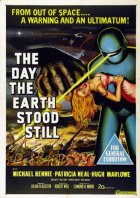
The Day the Earth Stood Still
- G
- Year:
- 1951
- 92 min
- 2,155 Views
EXT. BEACH - PACIFIC ISLAND - MED. SHOT - DAY
Backgrounded by palm trees and rolling surf, an American
army radar operator sits at his huge instrument, intently
tracking a target. Without interrupting this, he speaks with
tense excitement into a telephone transmitter strapped to
his chest. (It is 8:00 a.m.)
(In this and the subsequent scenes, music and cutting build
to an exciting crescendo).
EXT. FIELD - HONG KONG - MED. SHOT - DAY
A group of British soldiers, in shorts and tropical gear,
are gathered tensely around a piece of radar equipment, which
is tracking a target. The radar operator says something to
another soldier, who turns and speaks excitedly into a field
telephone. (It is 5:00 a.m.)
INT. INDIAN RADIO STATION - NIGHT
The microphone bears the word CALCUTTA. An Indian announcer,
his expression one of excitement and terror, jabbers into
the mike in a native tongue. A clock on the wall indicates
that it is 2:
26EXT. RUSSIAN BOMBER IN FLIGHT - (STOCK) - NIGHT
The plane is identified by a red star on the fuselage.
The radioman is tracking an object on his radar scope. He
points it out excitedly to the pilot. The pilot adjusts his
microphone and starts making a report back to his base in
Russian.
EXT. FRENCH VILLAGE - STREET CORNER - MED. CLOSE SHOT -
NIGHT:
A group of French farmers is collected around a radio,
listening wide-eyed to the keyed-up voice which is telling
them, in French, of a strange object that has been seen in
the sky. They exchange uneasy glances. One old man crosses
himself.
SPLIT SCREEN SHOT
RIGHT SECTION OF SCREEN SHOWS INT. AMERICAN RADIO STATION -
DAY:
A breathless American radio reporter is speaking into his
mike, but we can't hear what he's saying. On the wall behind
him is a clock which reads 3:32.
LEFT SECTION OF SCREEN SHOWS INT. BRITISH RADIO STATION -
NIGHT:
A clock shows the time to be 8:32. The British announcer
tries to maintain his traditional BBC calm, but finds it
almost impossible to control his excitement.
BRITISH ANNOUNCER
Reports are coming in from all over
the Empire -- from all over the world.
The Government have not yet issued a
statement, but there seems to be no
question that there actually is a
large, unidentified object circling
the earth at incredible speed.
This announcer keeps talking, but his voice fades out, and
now we hear the words the American announcer is saying...
AMERICAN ANNOUNCER
(staccato with
excitement)
We still don't know what it is or
where it's from –- but we do know
there's something there. It's been
tracked around the world by radar
traveling at a rate of four thousand
miles an hour.
INT. NEW YORK TAXI - DRIVER AND FARE – DAY
The driver and his fare are listening intently to the radio,
as we hear the voice of another radio reporter.
2ND RADIO REPORTER
(voice off scene)
This is not another "flying saucer"
scare. Scientists and military men
have already agreed on that. Whatever
this is -- it's something real.
The attendant, who is filling a car with gas, leans around
to hear the car's radio, oblivious to the fact that the car's
tank is overflowing.
3RD RADIO REPORTER
(voice off scene)
We interrupt this program to give
you a bulletin just received from
one of our naval units at sea. "A
large object, traveling at supersonic
speed, is headed over the North
Atlantic toward the east coast of
the United States."
Music builds to a climax and ends.
INT. WASHINGTON RADIO STATION
4TH RADIO REPORTER
(with deliberately
controlled calm)
Here in the nation's capital, there
is anxiety and concern, but no outward
sign of panic. As a matter of fact,
there are signs of normalcy that
seem strangely out of place; the
beautiful spring weather, the tourist
crowds at the various monuments and
public buildings...
EXT. LINCOLN MEMORIAL - LONG SHOT (STOCK)
A small crowd of tourists is climbing the steps to the
columned entrance.
EXT. WASHINGTON MONUMENT - LONG SHOT (STOCK)
Under this shot a barely audible, distant hum is heard. It
grows in volume so imperceptibly in this and the next two
shots that we are unconscious of it.
EXT. JEFFERSON MEMORIAL - LONG SHOT (STOCK)
Crowds are strolling on the Mall and across the well-kept
lawns in front of the Smithsonian Institution with the
leisurely, meandering quality that distinguishes sight-seers.
MED. SHOT
Including several small groups of people moving toward the
Smithsonian. Their attention is attracted as the hum off
scene becomes a roar. The sound is unearthly in its intensity
and almost unbearable in its swiftly increasing volume. The
people stop in their tracks and look up in the sky in terror.
Translation
Translate and read this script in other languages:
Select another language:
- - Select -
- 简体中文 (Chinese - Simplified)
- 繁體中文 (Chinese - Traditional)
- Español (Spanish)
- Esperanto (Esperanto)
- 日本語 (Japanese)
- Português (Portuguese)
- Deutsch (German)
- العربية (Arabic)
- Français (French)
- Русский (Russian)
- ಕನ್ನಡ (Kannada)
- 한국어 (Korean)
- עברית (Hebrew)
- Gaeilge (Irish)
- Українська (Ukrainian)
- اردو (Urdu)
- Magyar (Hungarian)
- मानक हिन्दी (Hindi)
- Indonesia (Indonesian)
- Italiano (Italian)
- தமிழ் (Tamil)
- Türkçe (Turkish)
- తెలుగు (Telugu)
- ภาษาไทย (Thai)
- Tiếng Việt (Vietnamese)
- Čeština (Czech)
- Polski (Polish)
- Bahasa Indonesia (Indonesian)
- Românește (Romanian)
- Nederlands (Dutch)
- Ελληνικά (Greek)
- Latinum (Latin)
- Svenska (Swedish)
- Dansk (Danish)
- Suomi (Finnish)
- فارسی (Persian)
- ייִדיש (Yiddish)
- հայերեն (Armenian)
- Norsk (Norwegian)
- English (English)
Citation
Use the citation below to add this screenplay to your bibliography:
Style:MLAChicagoAPA
"The Day the Earth Stood Still" Scripts.com. STANDS4 LLC, 2025. Web. 21 Jan. 2025. <https://www.scripts.com/script/the_day_the_earth_stood_still_1006>.




Discuss this script with the community:
Report Comment
We're doing our best to make sure our content is useful, accurate and safe.
If by any chance you spot an inappropriate comment while navigating through our website please use this form to let us know, and we'll take care of it shortly.
Attachment
You need to be logged in to favorite.
Log In